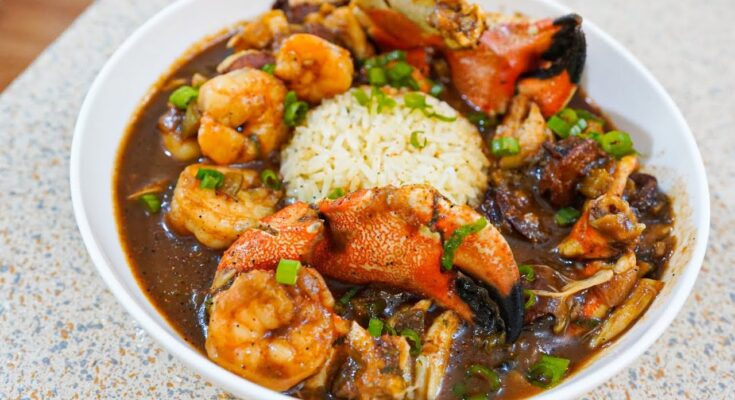Gumbo Recipe: Gumbo is a rich, flavorful stew that has become a culinary symbol of Louisiana, blending French, African, and Native American influences into a truly unique dish. It’s beloved for its hearty ingredients, bold flavors, and versatility—whether it’s packed with meats, seafood, or vegetables, there’s a gumbo for everyone. This recipe takes you through every step to create an authentic, soul-satisfying gumbo that’ll transport your taste buds to the heart of New Orleans.
This guide will provide everything you need, from choosing the right ingredients to mastering the art of making roux, and more. Let’s dive into the world of gumbo!
Ingredients Needed for Gumbo
Here’s what you’ll need to create a classic gumbo:
- Proteins: Chicken thighs, smoked sausage (like andouille), or seafood like shrimp and crab.
- Vegetables: Onions, bell peppers, celery (known as the “Holy Trinity”), garlic, okra (optional for thickening).
- Seasonings: Bay leaves, thyme, cayenne pepper, black pepper, salt, paprika.
- Stock: Chicken or seafood stock, depending on the type of gumbo.
- Thickening agent: Flour and oil for the roux, filé powder, or okra.
- Rice: For serving.
The key is balancing all these ingredients to get that traditional flavor, while also adding your personal touch!
Types of Gumbo
Creole vs Cajun Gumbo:
Creole gumbo uses tomatoes and tends to be more refined, while Cajun gumbo is heartier and often without tomatoes. Both are delicious, so it’s a matter of preference.
- Meat-based gumbo includes chicken, sausage, or even duck.
- Seafood gumbo has shrimp, crab, and oysters.
- Vegetarian gumbo features mushrooms, okra, and lots of vegetables.
Tools and Equipment
You don’t need fancy tools to make gumbo, but there are a few essentials:
- A large Dutch oven or heavy-bottomed pot for cooking.
- Wooden spoon for stirring the roux and gumbo.
- Knife and cutting board for preparing vegetables and meat.
- Ladle for serving.
Having these tools on hand ensures smooth cooking and better control over the process.
Making the Perfect Roux
The roux is the foundation of gumbo’s flavor, and getting it right is key. A roux is a mixture of fat (usually oil or butter) and flour cooked together. It can range from a pale blonde color to a deep, dark brown depending on how long you cook it.
Step-by-step guide to making a roux:
- Heat oil in a heavy-bottomed pot over medium heat.
- Slowly whisk in flour, stirring constantly.
- Continue cooking and stirring until the roux reaches your desired color. For gumbo, a deep brown roux is traditional—it can take 15-20 minutes of patient stirring!
Preparing the Ingredients
While the roux is cooking, you can prep the other ingredients:
- For chicken and sausage: Cut the sausage into slices and the chicken into bite-sized pieces. Sauté the sausage to brown it slightly before adding it to the gumbo.
- For seafood: Clean the shrimp and crab. Shrimp should be deveined, and crab shells should be cracked for better flavor infusion.
- For vegetables: Dice onions, bell peppers, and celery. Mince the garlic.
Building Flavor with the Holy Trinity
The “Holy Trinity” of gumbo is a mix of onions, bell peppers, and celery. This aromatic base forms the core of gumbo’s flavor.
- Once your roux is ready, add the Holy Trinity and sauté until the vegetables are softened.
- Add minced garlic and sauté for another minute.
- Stir in your seasonings (bay leaves, thyme, cayenne, salt, and pepper).
Combining Meat or Seafood with the Base
- For meat-based gumbo, add the browned sausage and chicken to the pot. Stir them into the roux and vegetable mix.
- For seafood gumbo, add the shrimp and crab toward the end of cooking, as they don’t need as much time.
Allow the gumbo to simmer so all the flavors can meld together. This is where the magic happens!
Adding Spices and Seasonings
To really elevate your gumbo, don’t be shy with the seasonings. Bay leaves, thyme, and cayenne pepper are essential, but feel free to adjust the spice level based on your taste. If you like it extra spicy, add more cayenne. Filé powder (made from ground sassafras leaves) is often used as a thickener and flavor enhancer in traditional gumbo.
Simmering the Gumbo
Simmer the gumbo for at least 1-2 hours to let the flavors fully develop. Stir occasionally, and skim any excess fat from the surface. Seafood gumbo should be simmered for less time to avoid overcooking the delicate seafood.
Serving Gumbo
Once your gumbo is ready, serve it over a bowl of fluffy white rice. You can garnish with freshly chopped green onions and parsley for added flavor and color. Gumbo is typically served with French bread or cornbread on the side to soak up the delicious broth.
Storage and Leftovers
Gumbo often tastes better the next day as the flavors continue to develop. Store it in an airtight container in the refrigerator for up to 3 days. If you want to freeze it, allow the gumbo to cool completely and then store it in freezer-safe containers for up to 3 months.
Tips for Making the Best Gumbo
- Avoid burning the roux. This is crucial as burnt roux will give the gumbo a bitter taste.
- Be patient. Letting the gumbo simmer for a longer time enhances the flavor.
- Customize to taste. If you want a thicker gumbo, use more okra or filé powder.
Variations of Gumbo
You can personalize gumbo based on the proteins you have available. Some popular variations include:
- Shrimp and crab gumbo – a seafood lover’s delight.
- Duck and andouille sausage gumbo – for a richer, gamey flavor.
- Vegan gumbo – use mushrooms and a variety of veggies like okra, carrots, and squash.
FAQs about Gumbo Recipe
1. What is gumbo?
Gumbo is a rich, flavorful stew originating from Louisiana. It’s typically made with a thick base, a variety of meats or seafood, and vegetables like okra, onions, and bell peppers. The dish is often served over rice.
2. What ingredients are essential for gumbo?
The essential ingredients for gumbo include a roux (a mixture of flour and fat), stock, meat or seafood (like chicken, sausage, or shrimp), the “Holy Trinity” of vegetables (onions, bell peppers, and celery), and okra or filé powder for thickening.
3. Can I make gumbo ahead of time?
Yes, gumbo can be made ahead of time. In fact, it often tastes better the next day as the flavors have more time to blend. Simply store it in the fridge for up to three days or freeze it for later.
4. How do I thicken gumbo?
Gumbo is traditionally thickened with a dark roux, okra, or filé powder (ground sassafras leaves). Each option adds a unique flavor and texture to the dish.
5. What type of rice is best for gumbo?
Long-grain white rice is the most common choice for serving with gumbo. Its mild flavor and fluffy texture complement the rich, hearty gumbo perfectly.
Conclusion
In conclusion, making gumbo is a rewarding process that combines layers of flavors, starting with the perfect roux and blending various ingredients like seafood, sausage, or chicken. The result is a rich, hearty dish that warms both body and soul.
Gumbo has stood the test of time as a comforting meal, enjoyed across generations and cultures, due to its versatility and ability to bring people together.
Don’t hesitate to try different variations—whether it’s adding unique spices or experimenting with proteins, each pot of gumbo can be a personal creation, perfect for any occasion.



